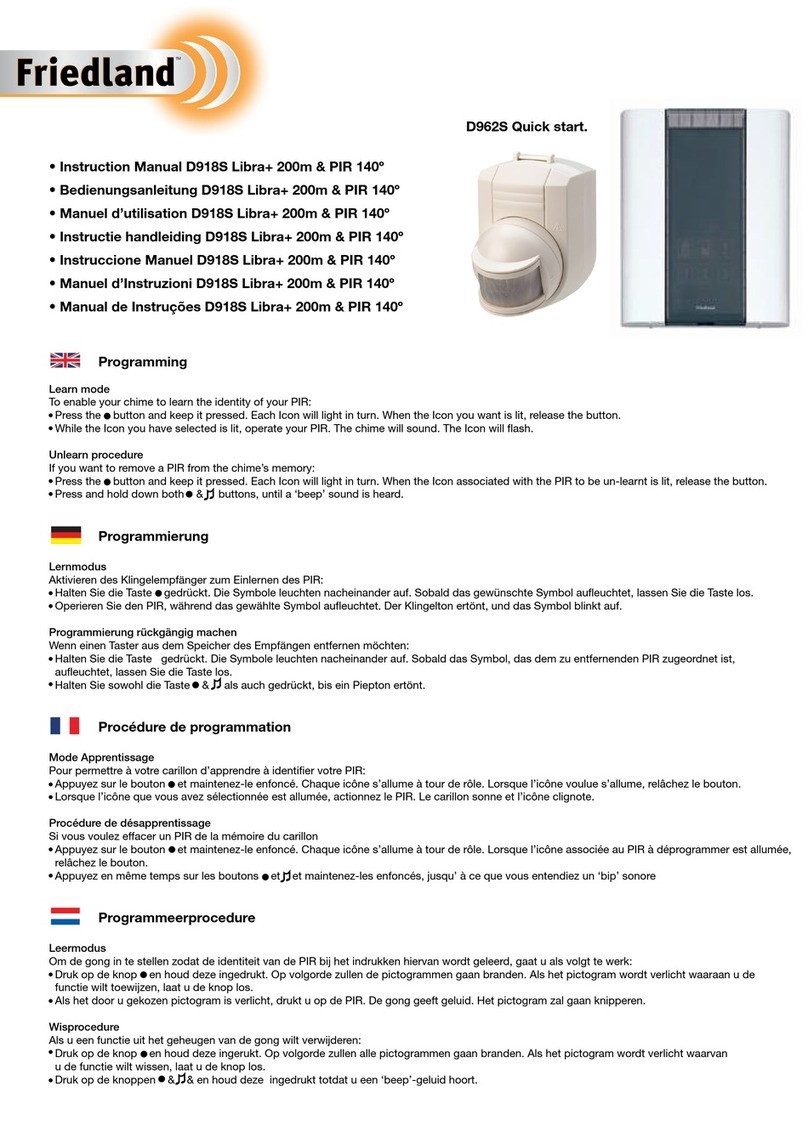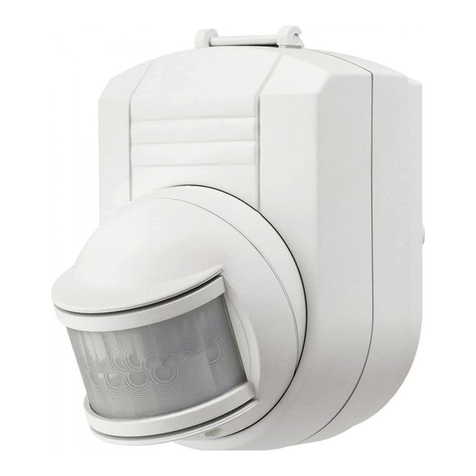2.
Ensure mains power is being supplied to the Receiver Unit.
3.
Walk across the detection area approximately metres from the PIR Detector. As you walk
through the first detection zone, the LED should light up. Now stand still until the LED goes
out - this should take about 1 second. The light fitting wired to the Receiver Unit will also
turn on for 3 seconds.
4.Start moving again. As you
cross each zone the LED and light fitting should illuminate as in step 3.
5.
Repeat steps 3 and 4, walking at various distances and angles to the unit. This will enable
you to discover the detection pattern.
6.If the detection area
7. SETTING FOR AUTOMATIC OPERATION
Having completed the ‘walk test’ procedure, you can set the unit for automatic operation as follows:
■Adjust the TIME control to the setting you require. This controls the length of time the
security light stays on once activated, after all motion stops. The minimum time (control
set fully anticlockwise) is about 1 seconds; the maximum (control set fully clockwise) is
approximately 1 minutes. Set the control at whichever timing suits you between these
limits. (see fig 17 for approximate position of time settings).
N.B
. Remember that the
time you set relates to how long the lamp remains on after all motion stops. If someone triggers
your lamp it will remain on for as long as that person keeps moving in the detection area, then
continue to illuminate for the timing you have set after all motion stops.
■The ‘LUX’ control enables you to set the system to become active when a certain level
of darkness has fallen each evening. Set the LUX by turning the control fully anticlock-
wise, and wait until darkness begins to fall. When it is dark enough for you to want the
lamp to be operative, turn the LUX control clockwise slightly, move your hand slowly in
front of the PIR, turn the LUX control a little more and repeat the procedure until the light
activates. Leave the control set at this point.
9. CLEANING
Occasionally use a soft damp cloth to gently clean the PIR unit lens and plastic case. Take
care not to accidentally move the detector head.
8. BATTERY REPLACEMENT
The PP3 9 volt battery should provide the PIR Detector with around 18 months operation*.
When the battery is nearing the end of its life - about 30 days before failure - the PIR
Detector sends a message to the receiver, EACH TIME IT IS ACTIVATED so that THE
LIGHT BRIEFLY TURNS ON, THEN OFF THEN ON AGAIN IN QUICK SUCCESSION. THIS
NOTIFIES YOU TO CHANGE THE BATTERY.
As this ‘change battery’ message will not occur for some time and you may forget about it in
the future, we have included a reminder sticker which should be positioned in a prominent
place.
*Depending on the number of activations each day and the effect of low temperatures.
Set timing control back as it was and set
lux control to a ‘brighter’ setting than
before. The conditions may have generally
been too bright for the detector setting.
An intermittent problem may also be due
to occasional radio interference.
SOLUTION
Try repositioning the
detector to allow
a stronger signal to
reach the receiver.
SOLUTION
Try repositioning or
adjusting the angle or
direction of the PIR
SOLUTION
TEST OK
The PIR ‘view’ may be obscured by objects that
partially hide persons to be detected (e.g. posts,
pillars). The PIR position or sensor alignment
PROBLEM
PIR
Radio transmission is not being received due to
distance or obstructions or radio interference. Also
large metal objects (including vehicles) close to
the Detector Transmitter or Receiver Unit can
PROBLEM
PIR detects effectively but light doesn’t operate
■The PIR Detector may be suffering from false activation. Check this by
completely covering the Detector’s lens with a thick cloth, masking
tape or a piece of cardboard. This will stop the Detector ‘seeing’ any-
thing. If the Detector now lets the light switch off after the set time and
does not light it again, this indicates that the sensor has been picking
up movement within its range. Slightly adjust the position/angle of the
PIR Detector to solve the problem. Masking the area of the lens corre-
sponding to the location of the interference is another solution; and
since the PIR Detector is wirefree, even moving it to a new location is easy.
■The level of light at the Detector may be too low for the current photo-
cell LUX setting, activating the unit as though it were night-time. In nor-
mal daylight, adjust the LUX control slightly anticlockwise. Wait outside
the detection area until the light goes out, then re-enter it. If the PIR
Detector still activates, the LUX setting is still too high. Adjust and test
again until the unit stops activating the light.
■The PIR Detector operates by sensing temperature differences. On a
cold winter’s night, body heat stands out more contrastingly from the
surrounding cold conditions,
so the PIR Detector is more effective. On a warm night the contrast is
not so great, and the detector is less effective. For this reason, it may
be necessary to make seasonal adjustments to the PIR Detector.
■The PIR Detector may be suffering from false activation. Check this
by completely covering the detector’s lens with a thick cloth, masking
tape or a piece of cardboard.
This will stop the Detector ‘seeing’ anything. If the Detector now lets
the light switch off after the set time and does not light it again, this
indicates that the sensor has been picking up movement within its
range. Slightly adjust the position/angle of the PIR Detector to solve
the problem. Masking the area of the lens corresponding to the loca-
tion of the disturbance is another solution; and since the PIR detector
is wirefree, even moving it to a new location is easy.
■Wind may be activating the detector, due to where it is sited; try it in a
different location.
■Small animals and pets may be affecting the unit - try masking the
bottom half of the lens to stop the Detector from picking up low level
objects.
■Also check that the PIR Detector is not sensing movement from near-
by traffic or pedestrians. Alternatively, for the above problems, check if
a nearby wirefree system is operating with the same code. In this
instance the light would still operate if the detector lens was complete-
ly masked off or if the battery was removed - change the coding if
necessary.
Light stays on
continually at
night.
PIR Detector
activates the light
in daytime.
Detection range
varies from day to
day.
Light activates for
no obvious rea-
son, at random.
PROBLEM SOLUTION
GUARANTEE
Friedland Limited guarantee that should any defects in workmanship or materials occur in this product within 3
years from the date of purchase, it will be replaced provided it has not been dismantled, altered, or a repair
attempted. To comply with the 3 year guarantee, the installation and usage of the product must be in accor-
dance with the Technical Specification above and in particular, care should be taken to ensure the maximum
switching loads are not exceeded. The product should be returned to place of purchase along with this manu-
al, the purchase receipt and details of circumstances of the malfunction given. This undertaking is in addition
to the consumer’s statutory rights and does not affect these rights in any way.
Friedland Limited, Houldsworth Street, Stockport, Cheshire SK 6BP, England
PIR MOVEMENT DETECTOR
Transmitter range - Up to 0 metres
Detection range - Up to 12 metres
Angle of detection - 140°
Battery life - Minimum 18 months, at 8 activations per day and constant 1 °C
Battery type - PP3 (6LR61) 9 volt alkaline
Time on adjustment - 1 secs - 1 mins
Photocell adjustment - lux to daylight
Temperature
operating range - -20°C to +3 °C
11. TECHNICAL SPECIFICATIONS
If your wirefree system fails to work properly, complete the relevant test or tests which follow.
10. FAULT FINDING
PROBLEM
Confirm that bulb, mains supply, and battery are operating correctly.
Also ensure that the system codes in each unit match, and that the
PIR is within the operating range of 0 metres. If all these are OK,
Although this is most likely to be an incorrect lux setting, first con-
firm that there is not another cause by following the next step.
TEST THE SYSTEM’S OPERATION
Carry out a ‘Walk Test’ (see section 6). This allows you to check that the
PIR is functioning, when it is functioning and whether the Receiver is
…Ever
…At night
Light does not operate when it should…
…Intermittently



























